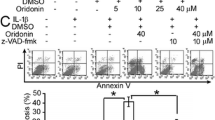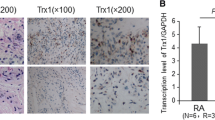Abstract
In the present study, we sought to explore the mechanism of quercetin-induced apoptosis in rheumatoid arthritis fibroblast-like synoviocytes (RAFLSs). DNA fragmentation assay was used to detect quercetin-induced apoptosis in RAFLSs. The cleavages of caspase-3 and caspase-9 and the accumulation of cytosolic cytochrome C were measured by western blot in quercetin-treated RAFLSs. Mitochondrial membrane potential was tested by flow cytometry. Small interfering RNAs were used to knock down the expression of protein 53 (p53) and analyze the role of p53 in quercetin-induced apoptosis in RAFLSs. DNA fragmentation assay showed that quercetin dose-dependently elevated the apoptosis of RAFLSs, accompanying with enhanced caspase-3 and caspase-9 cleavages. Moreover, quercetin caused a concentration-dependent loss of mitochondrial membrane potential and cytochrome c release to cytosol and also decreased Bcl-2/Bax ratio, indicating that quercetin-induced apoptosis is through mitochondrial pathway. Quercetin also elevated p53 phosphorylation at ser15. Pretreatment with pifithrin-α, a p53 inhibitor, significantly diminished p53 phosphorylation at the concentration of 30 μM and abrogated quercetin-induced apoptosis in a dose-dependent manner. Quercetin-induced apoptosis was also significantly blocked by p53 silencing, further suggesting the involvement of p53 in quercetin-induced apoptosis in RAFLSs. Our study indicated that quercetin-induced apoptosis of RAFLSs is through mitochondrial pathway, in which p53 plays an important role.





Similar content being viewed by others
Reference
Harris Jr., E.D., and Rheumatoid arthritis. 1990. Pathophysiology and implications for therapy. The New England Journal of Medicine 322: 1277–1289.
Tran, C.N., S.K. Lundy, and D.A. Fox. 2005. Synovial biology and T cells in rheumatoid arthritis. Pathophysiology 12: 183–189.
Firestein, G.S. 2005. Immunologic mechanisms in the pathogenesis of rheumatoid arthritis. Journal of Clinical Rheumatology 11: S39–S44.
Gay, S., R.E. Gay, and W.J. Koopman. 1993. Molecular and cellular mechanisms or joint destruction in rheumatoid arthritis: two cellular mechanisms explain joint destruction? Annals of the Rheumatic Diseases 52: S39–S47.
Huber, L.C., O. Distler, I. Tamer, R.E. Gay, S. Gay, and T. Pap. 2006. Synovial fibroblasts: key players in rheumatoid arthritis. Rheumatology 45: 669–675.
Pattacini, L., L. Boiardi, B. Casali, and C. Salvarani. 2010. Differential effects of anti-TNF-alpha drugs on fibroblast-like synoviocyte apoptosis. Rheumatology (Oxford, England) 49: 480–489.
Miyashita, T., A. Kawakami, M. Tamai, Y. Izumi, H. Mingguo, F. Tanaka, S. Abiru, K. Nakashima, N. Iwanaga, K. Aratake, M. Kamachi, K. Arima, H. Ida, K. Migita, T. Origuchi, S. Tagashira, F. Nishikaku, and K. Eguchi. 2003. Akt is an endogenous inhibitor toward tumor necrosis factor-related apoptosis inducing ligand-mediated apoptosis in rheumatoid synovial cells. Biochemical and Biophysical Research Communications 312: 397–404.
Palao, G., B. Santiago, M. Galindo, M. Pallá, J.C. Ramírez, and J.L. Pablos. 2004. Down-regulation of FLIP sensitizes rheumatoid synovial fibroblasts to Fas-mediated apoptosis. Arthritis and Rheumatism 50: 2803–2810.
Aupperle, K.R., D.L. Boyle, M. Hendrix, E.A. Seftor, N.J. Zvaifler, M. Barbosa, and G.S. Firestein. 1998. Regulation of synoviocyte proliferation, apoptosis, and invasion by the p53 tumor suppressor gene. The American Journal of Pathology 152: 1091–1098.
Chou, C.T., J.S. Yang, and M.R. Lee. 2001. Apoptosis in rheumatoid arthritis—expression of Fas, Fas-L, p53, and Bcl-2 in rheumatoid synovial tissues. The Journal of Pathology 193: 110–116.
Bae, S.C., W.J. Jung, E.J. Lee, R. Yu, and M.K. Sung. 2009. Effects of antioxidant supplements intervention on the level of plasma inflammatory molecules and disease severity of rheumatoid arthritis patients. Journal of the American College of Nutrition 28: 56–62.
Jackson, J.K., T. Higo, W.L. Hunter, and H.M. Burt. 2006. The antioxidants curcumin and quercetin inhibit inflammatory processes associated with arthritis. Inflammation Research 55: 168–175.
Sato, M., T. Miyazaki, F. Kambe, K. Maeda, and H. Seo. 1997. Quercetin, a bioflavonoid, inhibits the induction of interleukin 8 and monocyte chemoattractant protein-1 expression by tumor necrosis factor-alpha in cultured human synovial cells. The Journal of Rheumatology 24: 1680–1684.
Choi, E.J., S.C. Bae, R. Yu, J. Youn, and M.K. Sung. 2009. Dietary vitamin E and quercetin modulate inflammatory responses of collagen-induced arthritis in mice. Journal of Medicinal Food 12: 770–775.
Sung, M.S., E.G. Lee, H.S. Jeon, H.J. Chae, S.J. Park, Y.C. Lee, and W.H. Yoo. 2012. Quercetin inhibits IL-1β-induced proliferation and production of MMPs, COX-2, and PGE2 by rheumatoid synovial fibroblast. Inflammation 35: 1585–1594.
Ong, C.S., E. Tran, T.T. Nguyen, C.K. Ong, S.K. Lee, J.J. Lee, C.P. Ng, C. Leong, and H. Huynh. 2004. Quercetin-induced growth inhibition and cell death in nasopharyngeal carcinoma cells are associated with increase in Bad and hypophosphorylated retinoblastoma expressions. Oncology Reports 11: 727–733.
Arnett, F.C., S.M. Edworthy, D.A. Bloch, D.J. McShane, J.F. Fries, N.S. Cooper, L.A. Healey, S.R. Kaplan, M.H. Liang, H.S. Luthra, et al. 1988. The American Rheumatism Association 1987 revised criteria for the classification of rheumatoid arthritis. Arthritis and Rheumatism 31: 315–324.
Brunelle, J.K., and A. Letai. 2009. Control of mitochondrial apoptosis by the Bcl-2 family. Journal of Cell Science 122: 437–441.
Vaseva, A.V., and U.M. Moll. 2009. The mitochondrial p53 pathway. Biochimica et Biophysica Acta 1787: 414–420.
Zhao, H., F. Traganos, and Z. Darzynkiewicz. 2008. Phosphorylation of p53 on Ser15 during cell cycle caused by Topo I and Topo II inhibitors in relation to ATM and Chk2 activation. Cell Cycle 7: 3048–3055.
Natarajan, V., N. Krithica, B. Madhan, and P.K. Sehgal. 2011. Formulation and evaluation of quercetin polycaprolactone microspheres for the treatment of rheumatoid arthritis. Journal of Pharmaceutical Sciences 100: 195–205.
Choi, J.A., J.Y. Kim, J.Y. Lee, C.M. Kang, H.J. Kwon, Y.D. Yoo, T.W. Kim, Y.S. Lee, and S.J. Lee. 2001. Induction of cell cycle arrest and apoptosis in human breast cancer cells by quercetin. International Journal of Oncology 19: 837–844.
Lee, T.J., O.H. Kim, Y.H. Kim, J.H. Lim, S. Kim, J.W. Park, and T.K. Kwon. 2006. Quercetin arrests G2/M phase and induces caspase-dependent cell death in U937 cells. Cancer Letters 240: 234–242.
Jacquemin, G., V. Granci, A.S. Gallouet, N. Lalaoui, A. Morlé, E. Iessi, A. Morizot, C. Garrido, T. Guillaudeux, and O. Micheau. 2012. Quercetin-mediated Mcl-1 and survivin downregulation restores TRAIL-induced apoptosis in non-Hodgkin’s lymphoma B cells. Haematologica 97: 38–46.
Firestein, G.S., K. Nguyen, K.R. Aupperle, M. Yeo, D.L. Boyle, and N.J. Zvaifler. 1996. Apoptosis in rheumatoid arthritis: p53 overexpression in rheumatoid arthritis synovium. The American Journal of Pathology 149: 2143–2151.
Redondo, A., N. Estrella, A.G. Lorenzo, M. Cruzado, and C. Castro. 2012. Quercetin and catechin synergistically inhibit angiotensin II-induced redox-dependent signalling pathways in vascular smooth muscle cells from hypertensive rats. Free Radical Research 46: 619–627.
Hwang, S.J., B. Choi, S.S. Kang, J.H. Chang, Y.G. Kim, Y.H. Chung, D.H. Sohn, M.W. So, C.K. Lee, W.H. Robinson, and E.J. Chang. 2012. Interleukin-34 produced by human fibroblast-like synovial cells in rheumatoid arthritis supports osteoclastogenesis. Arthritis Research & Therapy 14: R14.
Lau, S.T., Z.X. Lin, and P.S. Leung. 2010. Role of reactive oxygen species in brucein D-mediated p38-mitogen-activated protein kinase and nuclear factor-kappaB signalling pathways in human pancreatic adenocarcinoma cells. British Journal of Cancer 102: 583–593.
Author information
Authors and Affiliations
Corresponding author
Rights and permissions
About this article
Cite this article
Xiao, P., Hao, Y., Zhu, X. et al. p53 Contributes to Quercetin-Induced Apoptosis in Human Rheumatoid Arthritis Fibroblast-like Synoviocytes. Inflammation 36, 272–278 (2013). https://doi.org/10.1007/s10753-012-9543-5
Published:
Issue Date:
DOI: https://doi.org/10.1007/s10753-012-9543-5




